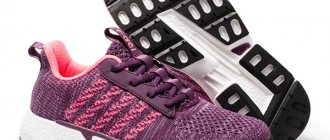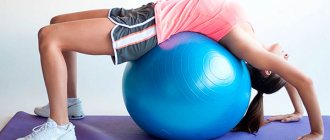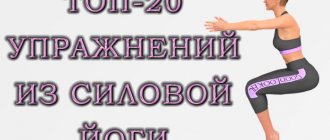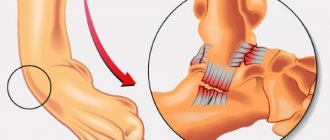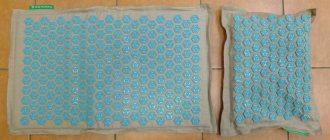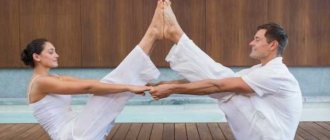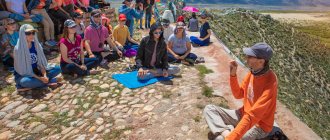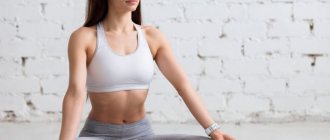Yoga mats are an essential attribute during practice, and the better and better the quality of the mat, the more effective and comfortable your workout will be. Often, yoga studios already have mats in common use, but it is better to have an individual mat for classes - you never know who has practiced before you.
In this article, we want to help you choose a yoga mat and tell you what a yoga mat should be based on the type of activity, location of training, level of training and personal preferences. We hope that after reading this you will determine the best yoga mat for yourself!
Basic criteria for a yoga mat
In order to choose the perfect yoga mat, you need to know what it consists of. There is a wide variety of yoga mats on a roll, and they all have the following criteria in common:
- stickiness;
- extensibility;
- weight;
- moisture resistance;
- dimensions - your height + 10-20 cm;
- width - from 60 cm;
- rug shape;
- thickness - the thicker, the more reliable, universal thickness is 4-5 mm;
- purpose - outdoor mats or for indoor training;
- material, its origin;
- brand, manufacturer's mark.
Discounts up to 25% on fitness and yoga products!
Partners
Using the links below you can order rugs from trusted stores. And with a promotional code, your purchase will cost you 10-20% less:
- 20% discount
on yoga products from the Yoga Club brand using promo code kiselevavru - Brand https://egoyoga.ru with beautiful children's rugs
- 10% discount
from the Russian manufacturer yogamatic when you enter the promotional code kiselevavru - 10% discount
in the Yogin store or 4yoga.ru using promo code kiselev (discount cannot be combined).
Yogamata size
Mats for practice have standard sizes from 183 cm to 220 cm for advanced practices, the width of the mat is 60 cm.
There are round corvicas and oval ones, for example for pair yoga.
The ideal yoga mat according to professionals:
- yoga mat should not be slippery;
- absorb moisture and evaporate it;
- suitable length for lying asanas;
- hypoallergenic and antiseptic;
- easy to use and wash;
- comfortable to wear, easy to fold.
European quality certificate
The European quality certificate confirms the fact that the rug does not produce toxic substances when it comes into contact with skin, and is absolutely safe for children. Such mats belong to the category of biodegradable materials.
Before buying a yoga or fitness mat, be sure to check whether such a certificate is available.
Introduction
My name is Kiselev Alexey. I have been teaching yoga for over 10 years. I conduct regular yoga classes and yoga therapy and courses for beginners. A common question asked in class is: “How to choose a yoga mat?” I already have a ready answer, which I repeat from time to time. First, I list a number of parameters that you should pay attention to. The weight of each of them depends on the needs of the person. Then I recommend several of my favorite models, talking about their pros and cons. I will do the same with this topic, only in reverse.
- The first article will focus on which rug to choose. What material and what brand?
- The second article is what parameters should be taken into account.
Why buy a rug?
It would seem, why buy a mat if most yoga studios provide yoga mats for free? The main reasons for purchasing a personal rug are usually the following:
- it is more hygienic;
- you can choose a rug according to your preferences;
- for practice at home.
Where to start when choosing a yoga mat?
Usually, when I am asked such a question after a class, I invite the person to look at the mats of the students and touch them all (with the permission of the owners), try to stand on them in asanas (for example, in downward-facing dog).
To understand what kind of surface you like, what thickness of mat is best, weigh it, understand what kind of grip it has, maybe stand on your knees or elbows and check whether its thickness suits you. This will save you from having to go to the store and you can buy the rug online. If you go to a store where all the products are presented, then there are usually small pieces of rugs that you can touch and evaluate the future rug for softness, structure and grip (“slipperiness”).
Then I usually recommend the following models. Moreover, I will immediately make a reservation that it is better to buy a mat in a specialized yoga equipment store, and not in a regular sportswear or supermarket.
If you are limited in money, then the following models are suitable:
- Ojas Shakti or Bodhi Lotus Pro - if you plan to exercise 2 times a week not very intensely and like comfort. Very soft, sticky, lightweight mats that absorb moisture. But with very active practice, they will begin to bleed within 1-2 years.
- Bodhi Rishikesh or Kailash - very wear-resistant, but more slippery, do not absorb moisture (i.e. they become even more slippery when sweating). They are more difficult for a beginner to practice on.
If finances allow:
- Rubber mat - Salamander Optimum or other options and brands - they are much heavier and 1.5-2 times more expensive. You can’t walk around the city all day with something like this anymore. Wear-resistant, absorbs moisture, good adhesion (sticky)
An even larger price category, more innovative and designer options - from combined surfaces.
- Rubber + cork,
- Rubber + non-slip coating
- Rubber + cotton (microfiber)
I like the companies Ojas, Bodhi, which have proven themselves for decades, and the Russian ART yogamatic.
The rugs shown in the tables below were specially selected to be approximately the same length (180*60cm) to make it easier to compare price and weight. There are other dimensions in length, width and other types of coatings.
I specifically added several low-quality “Chinese” brands to the table to compare the price, and the brands Reebok and adidas, because... These mats are also worthy of attention, but inferior to yoga ones. My second mat was a reebok and I practiced on it for several years, and my wife wore out several adidas mats before switching to rubber mats.
Composition of natural yoga mats
Natural yoga mats include:
- natural rubber - rubber is the most popular material for making rugs. The material is less durable in use than synthetic, but does not produce static electricity;
- jute is a natural elastic fiber that is produced from a plant of the Malvaceae family. The material is dense and durable, without foreign impurities. Also used in combination with synthetic materials, forming a natural coating;
- Cotton is a natural raw material that is used to reinforce rugs. Cotton gives the yoga mat durability.
Rubber yoga mats
Rubber yoga mats are more resistant to the absorption of unpleasant odors and are waterproof. Thanks to its grippy, non-slip surface and stability, the mat is very popular among practitioners and is classified as a professional mat. Rubber mats can be used for any direction: Ashtanga yoga, hatha yoga, etc.
Read a review of the rubber mat here.
The main feature that distinguishes them from synthetic analogues is that rubber mats have a mat thickness of 3-5 mm and weigh from 1.5-2 kg. This is the minimum weight of such a roll since rubber itself is a heavy material.
Recognized as the most environmentally friendly rug, it does not cause allergies and is a biodegradable material.
Caring for a natural rubber rug
After purchasing, the first thing you should know is how to clean yoga mats - you need to wipe the surface of the mat with a damp household wipe. You may see dust sticking to the rug; this effect will disappear after 1-2 weeks of wet cleaning. Rubber also requires special handling:
- water no more than 30 degrees;
- simple detergents;
- no machine wash;
- dry the mat completely unrolled;
- Keep rolled up until next practice.
You can also find special products for cleaning rugs. Manufacturers produce non-slip mats for their own products: Bodhi, Manduka.
Jute rugs
A jute carpet is suitable for both individual training and group practice. Thanks to the natural composition of the roll, it will last a long time and will delight you with good adhesion.
The rug can be washed with a drop of detergent at a temperature of no more than 30 degrees. For light stains, wipe with a damp cloth.
Cotton yoga mats
Quite dense and durable yogamats that are suitable for more humid conditions, for example as a hot yoga mat. The mat may slip during normal activities, so it is recommended to use an additional layer of non-slip mat underneath.
The main advantage of such a rug is its exceptional naturalness. Eco-friendly cotton quickly absorbs water and can be bent and folded however you like.
Can be used as a cover on a thin yoga mat as a blanket for a more comfortable practice.
Yoga mat Bodhi Shiva 200x70x0.3 cm
Popular manufacturers of cotton goods: Bodhi, Tribe.
Editor's Choice
Indigo IN106 (from 1590 rubles)
Indigo IN106.
Photo: yandex.market.ru The Indigo IN106 mat is made of thermoplastic elastomer. It gives this yoga equipment such useful qualities for training as elasticity, antibacterial, and resistance to heat from sunlight. Retains its shape well in hot and cold conditions. Sweat-resistant, eliminating the risk of slipping during exercise. Add a stylish appearance to your strengths. The mat is soft and pleasant to the touch; doing exercises on it is very comfortable. Does not have an unpleasant odor. It is better not to exercise in sneakers, as marks may remain. It has a rectangular shape. Dimensions of the rug: length - 173 cm, width - 61 cm, thickness - 0.5 cm.
Advantages and disadvantages
Soft, pleasant to the touch
There are no elastic bands to secure it when folded - it will be inconvenient to store and carry it
show more
KETTLER 7351-120 (from 4990 rubles)
KETTLER 7351-120. Photo: yandex.market.ru
Folding mat KETTLER 7351-120 is an ideal option for those who like to travel and play sports. Suitable for stretching, Pilates, yoga, and classic strength exercises with your own weight. Strengths: Provides good stability when performing exercises regardless of the floor surface. When folded, it can be used as a block or a balancing platform. The ability to fold greatly simplifies the transportation and storage of this equipment. What is important is that there are no creases or deformations when folding. When unfolded, it takes the shape of a rectangle 180 cm long, 60 cm wide and 0.6 cm thick.
Advantages and disadvantages
Excellent combination of softness and elasticity. folds compactly
When used on tiles, the lower part becomes electrified
show more
Lite Weights 5410LW/5420LW (from 956 rubles)
Lite Weights 5410LW/5420LW. Photo: yandex.market.ru
The Lite Weights 5410LW/5420LW double-sided mat is made of modern NBR material (acrylic nitrile butadiene rubber) in the shape of a rectangle. This material allows it to be both soft and strong enough to withstand mechanical loads well. Designed for fitness training, aerobics, yoga. Has good grip on the body, reducing the risk of slipping during exercise. Easy to wash, store, roll up. For this purpose, the kit includes a special elastic band. The length of the mat is 180 cm, that is, it will suit a person of fairly tall height, the width is 60 cm, which is quite standard. It is 1 cm thick. This is quite a lot. The rug weighs a little less than a kilo - 0.85 kg.
Advantages and disadvantages
Thick, elastic band included
Rubber smell upon first use
show more
Composition of synthetic yoga mats
- PVC is a material characterized by elasticity and strength. Most rugs are made from polyvinyl chloride and have an above-average service life. The price of PVC yoga mats is an order of magnitude lower than mats made from natural materials;
- TPE is a new generation biodegradable material. It is also called thermoplastic elastomer: hypoallergenic and antiseptic, does not absorb dirt and sweat, washes well with soap and has a pleasant texture to the touch;
- microfiber is a universal material that does not fade, is not heavy, and is resistant to external influences.
PVC yoga mats
Rolls of such material are produced and purchased most often. Despite its affordable price and greater availability, synthetic material can easily be damaged - scratched, or even torn. The lifespan of the carpet is 1-2 years. Given this period of time, the rug fully justifies its cost.
Example of brands of PVC mats: Rishikesh, Kaliash.
TPE (thermoplastic elastomer) mats
Thermoplastic elastomer mats are much softer than PVC mats. Hypoallergenic, hygienic material, excellent resistance to environmental influences. Suitable as a sports mat for fitness training, Pilates, yoga.
Another use for the mat would be to use it as an army mat.
Thermoplastic elastomer mats are sometimes confused with rubber mats due to their similar appearance. When choosing an exercise mat, be sure to read the description on the product label.
Brands that make this type: Bodhi, Yogitoes, Manducka, Relaxus.
Microfiber mats
They are also called suede because of their external similarity and tactile sensations. The mat consists of 2 layers of rubber material and a thin layer of microfiber.
Microfiber yoga towels, like cotton ones, are more suitable for humid and hot conditions with increased sweating.
They are very easy to machine wash and wipe with a damp cloth for light stains.
Mid-price mats (TPE mats)
Along with German-made PVC mats in the mid-price category, TPE mats
(thermoplastic elastomer).
Unlike PVC mats, they are lighter, often double-sided (both sides are working), and have a perforated texture.
The length of such rugs is usually up to 183 cm, thickness 4-6 mm
TPE mats are easy to care for, easy to clean, quite durable and have good anti-slip properties
.
Of the minuses, it is worth noting that the edges of the mat may bend slightly after long-term storage rolled up, but this is not a big drawback.
Also mats 6 mm thick
They are quite large when storing and carrying; for compactness and ease of storage, it is recommended to use a special
tie for rugs
.
Such rugs are produced in China and sold under different brands, including European, Russian, and American.
These rugs are very convenient to take with you. Perfect for both beginners and professionals. It should also be noted that there are many bright, interesting colors in each model.
Synthetic material or natural?
If you are a beginner and choose a yoga mat for training at home or in yoga halls, polymer mats will be the best option for practicing yoga for beginners. Inexpensive and simple, just right for training on an individual mat.
For professional training, the best solution would be a mat made of natural rubber. A mat made of natural rubber is absolutely non-toxic and has the highest stickiness when in contact with the skin and the floor. It is convenient to wash. The only disadvantage of natural material is its weight. Rubber mats are quite heavy, weighing from 2-3 kg.
Universal training mat
General purpose mats are widely available in almost any gym but are also great for home use. Its main purpose is to cushion the body throughout the entire workout, and is usually short and thick. Ideal for any floor workouts such as squats or planks.
There are three main types of general purpose training mats.
- Vinyl is foam plastic with a vinyl coating. These mats are durable and easy to wipe clean. Able to withstand repeated use.
- TPE is a thermoplastic elastomer material. These mats are comfortable, durable and the most environmentally friendly material as they can potentially be recycled. The elastic properties allow the mat to return to its original shape after use, but also provide a soft and comfortable feel.
- EVA - foam mats. Lightweight and affordable. However, they are not designed for you to exercise in sports shoes. Otherwise, the mats will not provide you with proper cushioning.
Travel yoga mats
Every person who regularly practices yoga should have a travel mat in their collection. The main features of this Travel Yoga Mats:
- lightness - weight up to 1 kg;
- high stickiness;
- the ability to fold tightly into any shape;
Due to the ability to conveniently fold into any bag, travel mats are also taken for group classes in a yoga studio.
Which fitness mat to choose?
The most popular type of mat is training mat. They are used both at home and in fitness clubs due to their versatility. They usually come in two sizes: 200 x 100 cm and 200 x 120 cm, but can be smaller (eg 50 x 140 cm).
Thickness - from 5 to 6 mm. It should depend on what activities you need the mat for. For example, if you do light exercises such as stretching or Pilates, during which you are barefoot and have frequent contact with the floor, then you should choose a soft mat that is at least 5mm thick.
If you plan to exercise regularly and intensively, then choose a mat with a protective coating to increase its durability.
Original rugs
Cork yoga mats
The mat consists of two layers that are bonded under high temperature. The top layer is made from the bark of a cork tree. When cork is extracted, the tree itself does not suffer, because This is the only tree in the world whose bark is capable of self-regeneration.
The second layer is made of natural rubber and has good density and elasticity.
The thickness of such a mat is on average 4 mm and exercises on a hard surface will be more than comfortable. It can also be used as a gymnastic mat both at home and in gyms.
Manufacturers assure that the cork layer of the mat does not crumble at all during use and retains its original shape for a long time.
Sheep wool yoga mat
This cozy rug is made of natural sheepskin. The mat will protect you from the cold floor, provide pleasant tactile sensations and allow you to relax more after training. Some sites offer them as baby rugs made from eco-friendly materials.
In addition to sheep wool, the rug contains rubber, which is used to cover the backing, as well as polyurethane and acrylic.
Wool is a natural and renewable resource that is resistant to moisture, fire and dirt. Manufacturers of yoga mats made of wool claim an environmentally friendly and non-violent approach and cut the animals in such a way that they receive the least harm.
Round yoga mats
According to the manufacturers, round practice mats provide a 360-degree range of motion. In our opinion, they are not as comfortable as rectangular shapes. This is more like an addition to a future collection of yoga equipment.
Designer yoga mats
There are yoga mats with unusual beautiful designs and beautiful patterns.
What qualities should a good training mat have?
- Versatile and practical - it should be suitable for various types of exercises - general development, yoga and Pilates.
- Easy to use - rolls out, with additional straps that protect it from unwinding accidentally.
- Easy to keep clean - preferably with a smooth surface that can be washed in the washing machine.
- Eco-friendly - Unfortunately, 95% of rugs on the market are made from PVC, which takes hundreds of years to decompose and pollutes the environment. By purchasing several cheap rugs throughout your life, you are accelerating environmental pollution. Rubber mats are biodegradable and environmentally friendly - the best possible solution.
- Aesthetics – If you're already investing in a mat, it's worth choosing one that's simply beautiful and whose appearance will further motivate you to exercise. Rugs come in a variety of colors and patterns—what you choose depends on your charisma, temperament, preferences, and the type of discipline you practice.
Yoga mat cover
A yoga mat cover is an important accessory for going to the gym and storing your mat. A good cover protects the mat from damage and dirt and will be convenient if you want to work out in another place.
When choosing a cover or bag for yoga mats, you need to measure the width of the mat. The parameters are always indicated on the product and you can easily choose the ideal size rug.
Carpet bag Foyo Black
Mat cover FOYO Night
Bag-case for yoga and mat Foyo Cherry Love
It is important that the case is durable and can withstand several kg. This parameter should be taken into account by those who have a professional yoga mat that weighs 2-3 kg.
It would be good if the cover was made of natural material, allowed air to pass through and did not retain moisture. This will help your rug stay looking fresh longer.
And, of course, the design of the case. Nowadays, various colors and textures are available, which can be selected, first of all, to suit the style of clothing.
Choosing a yoga mat cover is easy; the most important thing is to know what you need.
Not suitable for comfortable yoga classes (not comfortable)
First, I will list the mats that are not suitable for a comfortable yoga practice.
Travel mats
They are slippery, especially when wet (from sweat), so your legs and arms will move on them.
They are light and cheap, but can slide on a smooth floor, are bulky, and curl. Some people drag, which interferes with practice. Price – about 300-600 rubles. But sometimes, when taking part in a yoga tour with a trip to the mountains, they practice on them.
Usually made from PPE (polyethylene foam, polyethylene foam) and PSEV (physically cross-linked polyethylene foam).
Travel mats
Travel mats
Travel mats
Thick and stretchable fitness mats
Fitness mats, usually 10, 12 or 15 mm thick, most often made of NBR material (NBR or NBR - nitrile butadiene rubber), are not suitable for yoga for two main reasons:
- the thicker the mat, the less stable it is for balance poses (on one leg or arms) - and this is an important part of yoga exercises
- Usually such mats stretch, but this interferes with yoga practice
The cheapest yoga mats. Cheap PVC or EVA (Ethylene Vinyl Acetate)
I don’t recommend to anyone the very cheap mats that are sold in sports stores and supermarkets in the sports department, sometimes as part of a yoga kit, for about 1000-1500 rubles.
These carpets are usually of poor quality. Hands and feet slip on them, especially if they get a little sweaty. However, you can buy such a rug as a spare one to take it to those places where it would be a pity to take the main rug. For example, on an away yoga tour, especially if it includes air travel, so that on the way back you don’t have to overpay for the weight and dimensions of luggage and leave the mat at the host studio. Or if you are going to an eco-seminar, when classes are held outdoors without special covering (on the ground, sand, in the forest) and it would be a shame to damage an expensive rug.
Yoga mat review: video
Conclusion
To summarize, we would only recommend choosing a rug made from more natural materials that will last longer and will not harm the environment. After all, today the issue of preserving the environment is more important than ever.
Let your mat bring you only pleasure and motivate you to become better every day and transfer your small victories into real life.
Please share in the comments what is the ideal yoga mat for you?
4 / 5 ( 4 voices)
Bottom line
This article discussed all the main materials from which rugs are made. Based on your preferences, budget, intensity of practice, and tendency to sweat profusely, you can choose which mat is best for you. We definitely DO NOT take:
- travel rugs;
- thick fitness mats;
- cheaper than PVC, less than 1000 rubles, and in non-specialized stores.
We give preference to:
- If you are limited in money, do not plan a very intensive practice yet, want a mat that is lighter and not very slippery - take it from TPE / TPE material (Thermal Plastic Elastomer / thermoplastic elastomer). For example, Ojas Shakti, Bodhi Lotus Pro, Devi Yoga Fruits;
- Also relatively cheap, very wear-resistant, but more slippery and heavy - PVC (PVC - polyvinyl chloride): Bodhi Rishikesh, Kailash;
- If you sweat, then buy a microfiber towel covering for them;
- Eco-friendly, very sticky, but more expensive than rubber ones. For example, Ojas Salamander (different colors, thickness and length);
- If you want a high-quality rug that is beautifully designed, with two surface options, then choose combined options:
- Rubber + cork – pleasant to the touch, but after a few years it begins to crumble;
- Rubber + non-slip coating - soft, laser-etched, good grip;
- Rubber + cotton (microfiber) – pleasant to the touch, glides dry, sticky when wet, beautiful patterns;
- For meditation and pranayamas, rugs made of cotton, wool, jute, and Kush grass may be of interest.
I like the companies Ojas, Bodhi, Manduka, which have proven themselves for decades, and the Russian ART yogamatic.
Support domestic producers
Demix is a Russian brand that specializes in the production of fitness equipment and other equipment, and its products are available in all sports stores.
The brand has a huge variety of fitness mats for every taste, which differ in density, size and color. Moreover, each Demix mat has a non-slip surface and is equipped with carrying straps. The line includes both budget models and more expensive ones, but with an enhanced shock absorption effect.
Caring for and storing the rug
How to properly care for a yoga or fitness mat so that it lasts long after purchase? Let's share a few tips that may help you.
During training, we recommend removing shoes and all jewelry. This is necessary so as not to damage the surface of the mat.
For storage, it is better to roll the rug rather than fold it. After folding, the inventory may develop creases or grooves in the folded areas. This will make training uncomfortable.
The rug should be rolled up with the bottom side inward. This way, the edges of the sports accessory will not bend upward during training.
Synthetic yoga or fitness mats should be wiped with a damp cloth with warm water or antibacterial soap after each workout. To remove sweat and prevent the development of bacteria.
We hope this information will help you choose the right yoga or fitness mat. And if you want to test this sports accessory, we are always waiting for you in our sports equipment salons in the Globo shopping center and the Castle shopping center.
German quality
Kettler is a large manufacturer of sports equipment known throughout the world. For the fitness industry, the brand offers rugs and mats for regular workouts, and lightweight mats for yoga.
The Kettler PVC mat also features training exercises along with descriptions. Moreover, for each of them, various variations of execution are offered depending on the purpose of your workout, and the muscle groups involved are also indicated. The manufacturer claims that following the recommendations on the mat helps develop flexibility, strength, muscle tone, contouring and cardiovascular endurance. Dimensions: 170 x 68 cm, width - 2.5 cm.



